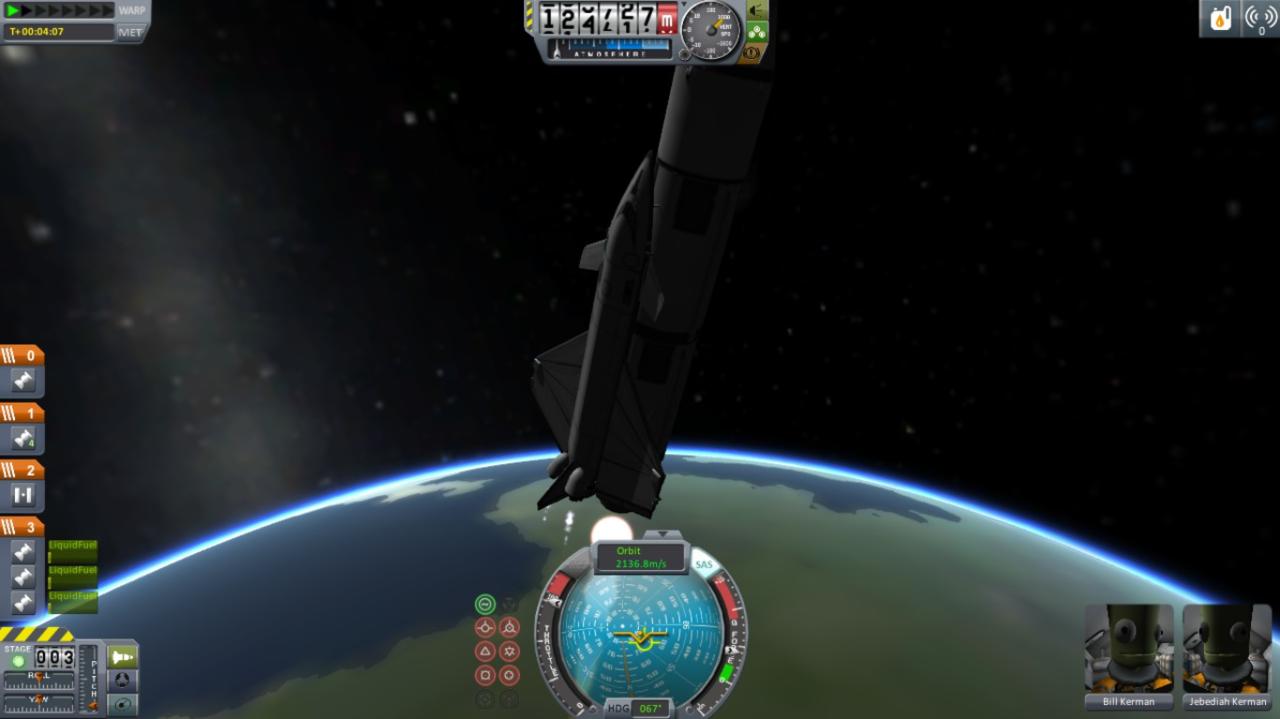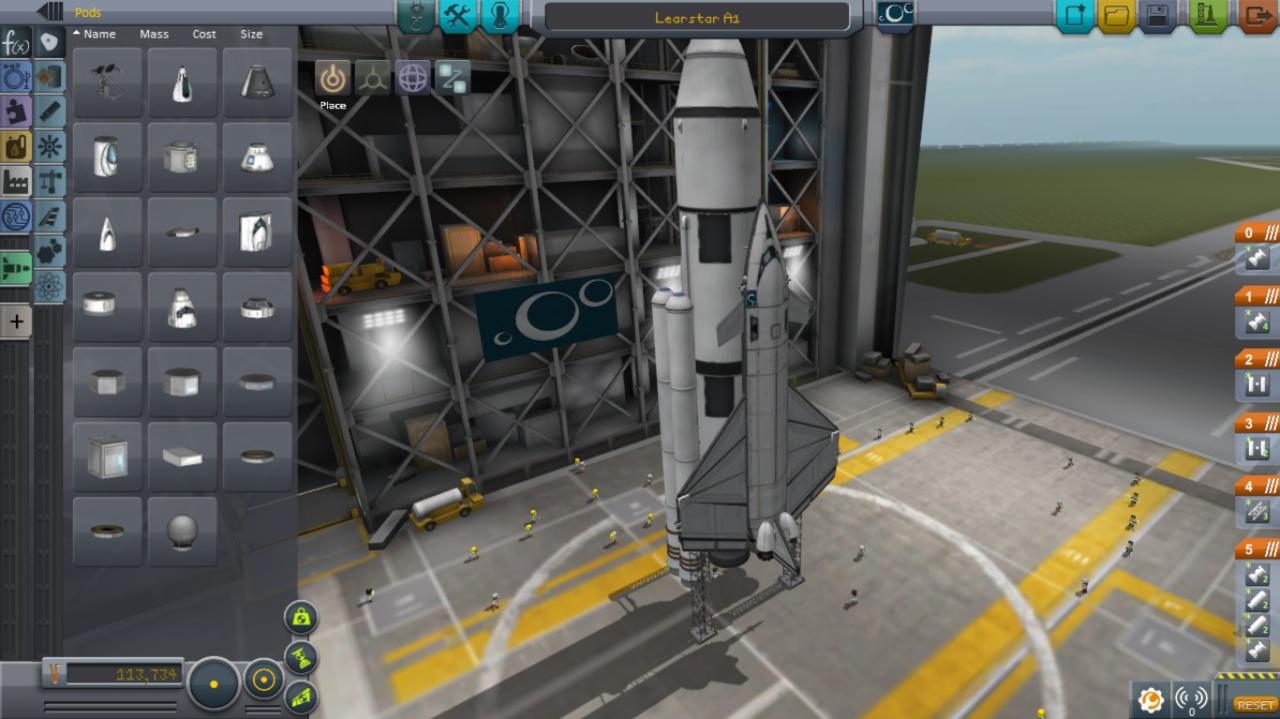Update: We've updated our review to reflect the changes made to the PS4 and Xbox One versions of Kerbal Space Program. Please scroll to the bottom of the story to find the updated content. - PB, 7/26/2016, 12:42 PM PDT
Two astronauts are dead. And they represent one of my greatest achievements in a video game.
Of course it's terrible that the two Kerbals--an entire species of little green alien men who feel like an unholy combination of the Minions from Despicable Me and the Irken race from Invader Zim--are dead. I managed to keep them alive through disaster after disaster, spending hours ensuring to their survival in the cold black of space. Test missions were flown; probes collected scientific data; rockets would refuse to leave the ground and would explode or launch and then immediately tip over because the balance was wrong. These two died based on the collective knowledge of a thousand failures. And it was beautiful because they died crashing into the Moon. Sorry, the Mun.
It doesn't really cover it to say that Kerbal Space Program is a space sim. For one thing, no matter how serious things get, you're still playing in a world of little green cartoons, which the game never really reconciles with its overwhelming physical realism the further along you go. But for all the things that feel brain-bending and sciencey, there's still a mild sense of approachability, like the fact that trying to plot a flight path that puts you in orbit with a different planet is essentially a really touchy and precise game of Bop It. The game surpasses that categorization because of that sense of constant discovery and innovation. Making a mistake never felt like a punishment, as if the game had placed an insurmountable obstacle in front of me and laughed as I flailed wildly at it. It felt like growth. Failure is a teacher here, one that challenges you and doesn't compromise by handing you all the answers. But it is most certainly a teacher that wants nothing more than for you to find enlightenment.
As such, trying to nutshell Kerbal Space Program isn't a matter of straightforward "You win if you get here" goals. As far as I can tell, the game never stops, and an entire solar system waits out there to be explored. What KSP values above all is perseverance. Although all your scientists and pilots are little green men, the game is intrinsically human. You advance simply by being bold enough to try reaching a little higher, making your species' sphere of influence just a little larger with every attempt. If you manage to break the world's speed record, you're ready to try reaching the upper atmosphere and recording how the air is up there. If you get there, then maybe we can put a satellite even further. If the satellite can get up there, maybe an astronaut can. If we can reach space, we can reach our closest planetary neighbor. All that matters is that the experience is never wasted. Whether you transmit the knowledge using an antenna you attached to your spacecraft or you manage to land safely and the data can be recovered manually, Mission Control receives the experience, shown under a blanket stat of "Science" in-game. If the mission crashes and burns horribly, it is worthwhile as long as you recognize why.

Unsurprisingly, most of your time in-game is spent in the spaceport on a constant trial-and-error mode trying to build a craft that can do exactly what's required for the mission at hand. The game isn't going to blow your mind visually or aurally--land, sea, space are all relatively textureless and sparse, even with all the specs cranked up, and the sounds are about the same, with the soundtrack topping out at "playfully quirky" instead of awe-inspiring. All the horsepower has gone into making the fine kinetic details almost terrifyingly intricate. Virtually every aspect of a spaceship's design is accounted for here, with literally hundreds of design options and moving parts to assemble--from fuel tanks and rockets to the heat shields for re-entry and the decoupling devices for boosters. And you’d better take all of it into consideration or sure as you're born, it will crash and burn before you even see the stars. It's daunting, but starting small and adding new tech onto successful structures is where joy is found. The actual crafting process is dirt simple, however, because every part is basically attached to your craft like Legos. There's a slew of fine-tuning tools available for the more meticulous player, but it takes a long time before they become necessary evils.
Kerbal Space Program offers straightforward Easy-to-Hard difficulty settings, but in reality, the real difficulty setting is almost allegorical. The Sandbox mode opens up every available part in the game so you can just fool around and make the most elaborate, insane designs imaginable. The Science mode allows you to earn points for every new milestone achievement; you can spend those points on the Research and Development skill tree, which is where you earn bigger and better parts to use. The Career mode is a full-blown space program experience where money is, in fact, an object and good public opinion, public donations, government contracts, and farmed-out tech are required to before you can even afford to send astronauts on a flight. This is the most "gamey" it gets, with contracts representing clearly defined missions you can perform to get the most out of every flight. It's slow going, but it’s possibly the most satisfying because every new advancement is earned.

Both the Science and Sandbox modes feature pre-made spacecraft you can take out into the final frontier, but while it is a huge relief to not have to put in the clearly elaborate wrench time to build anything this complex, there's something a little hollow about just having these accomplishments tossed at you instead of reaching them yourself. The game almost makes up for this because even with a few extensive tutorials tossed in, getting a ship to the Mun involves a hundred tiny decisions you won't realize you’re making because you don’t have to make them time and time again. The stages of every launch have to be programmed in, sufficient fuel has to be stocked to make it where you're going and back, and ship stability has to be minded (even with the SAS feature, which is there for the express purpose of keeping your ship in balance). The blue navigation ball at the bottom of your screen is your best friend in the world, and ignoring it is a fool's act. Career mode is harder yet infinitely more satisfying when you find success. Even when you forge the most ridiculous-looking rocket, it’s a wonder of engineering as long as it breaches Kerbal's atmosphere and doesn't explode. True human achievement, in life as in this game, works at a snail's pace. It can't be given.
Once you have your spacecraft, the real struggle begins. And your opponent is gravity.
Gravity keeps your craft from lifting off when you've loaded it down with too much rocket fuel. It tilts your ship as it takes off if the thrust is even a tiny angle off-kilter. You fight it in the upper atmosphere as you try to put spacecraft in orbit instead of watching them fall helplessly back to the ground. You will charge against it as you try to create a new orbital path to get to a new planet, and all the tutorials do is teach you the basic principles. They don't tell you what parts you need to make these things any easier in practice (in case you haven't figured it out, the tutorials are kinda useless).
You advance simply by being bold enough to try reaching a little higher, making your species' sphere of influence just a little larger with every attempt.

But this is simply nature in action. Unlike, say, Surgeon Simulator or one of the new breed of indie titles with sloppy, inebriate physics, KSP's natural laws feel like a natural part of the universe’s uncaring nature instead of the developer’s attempt to stymie progress. It's up to you to use the tech at your disposal to break nature's shackles and crack the science necessary. This is often an arduous, aggravating process, where hours slip away as you try to find the one flaw in an insanely elaborate series of maneuvers that’s causing your missions to fail. The tiny moments when something clicks into place and one more of those chains breaks are the most breathtaking and gratifying of all. Once again, there's still even further you can go.
Kerbal Space Program was a beta release for years before this, its "final" version. Funny enough, even after all that time, bugs are still scattered throughout, such as ships that are no longer visible, orbital paths turning twitchy and changing randomly even as your ship follows the one you set, and button presses not registering as you float out of your ship . But these are small compared to what feels like the mass achievements of thousands of minds bringing their expertise to the table through the hundreds of tweaks done over the years to the clearly passionate, lovingly crafted mods, which are easily accessible and promoted in-game. Even NASA's gotten in on it with a few of their own hypothetical scenarios pre-loaded in the game from the get-go. On the micro and macro levels, Kerbal Space Program's greatest magic trick is giving the player a feeling of togetherness, that we all have the same curiosity required to transcend our limitations and that regardless of how Herculean the stakes, the constant idea is always "it can be done."

Instead of altering the layout of Kerbal's UI for consoles, Squad attempted to impart of all relevant keyboard and mouse functionality onto controllers. As a result, text and icons are microscopic on a big-screen TV, and though the UI can be scaled up in size, you sacrifice valuable screen real estate in the process. If ever there has been a perfect excuse to implement second screen capabilities, this would have been it. Most of the hard work in Kerbal Space Program—building craft, moving parts around, turning flight controls on or off--requires more precision than either the Dual Shock 4 or Xbox One controller offer.
A mouse arrow can be turned on and off with a click of the left analog stick, and in use, it excels at inputting large sweeping motions, but not fine movements--at least PS4 players have the option to use motion controls for marginally better cursor control. Surgical procedures like plotting orbits can be done, with time, effort, and trial-and-error, but a game that already has a Sisyphean learning curve certainly didn't need anything to create more work for the player.
You will fail at this game. It will demoralize you and it will stress you out, but, more often than not, it will soothe, quiet, and inspire you. Innovative muscles will be stretched here that aren't stretched very often by games, and more complex moments require a sort of zen beyond being simply twitch-ready for a surprise attack. Even failure imparts a lesson. No matter how big or small the achievement, anything else that can be done is limited only by your imagination. Even with its cartoonish humor and quirks, Kerbal Space Program has an almost sacred respect for the tiny miracles involved in space travel, and even at its most difficult, it deserves that respect in return.